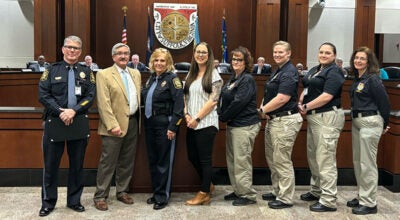Teen driving distractions can be deadly
Published 7:08 pm Saturday, June 4, 2016
By Alyssa Branch
Intern
Memorial Day began the summer driving season, a stretch that AAA has called the “100 Deadliest Days” of the year because distracted teen drivers are at greatest risk — and pose the greatest risk to other drivers — during that period, according to the automobile club.
According to research by the AAA Foundation for Traffic Safety, 60 percent of crashes involving teenagers include some form of distraction behind the wheel. Last summer, teen car accidents rose to 5,180, leaving 1,189 teens injured and 14 dead across the nation.
Those crashes resulted in an additional 1,808 injuries and five fatalities to people other than the teen drivers involved.
“It is definitely a concern how we lose teen drivers in fatalities due to inexperience or distractions”, said Sharon Lynch a Suffolk State Farm Insurance agent.
Most people would think of the icy months as the most dangerous times for teen drivers, but the amount of traffic during the summer, along with the fact that teens drive more during the summer, makes it a much more dangerous period for them. In comparison to the rest of the year, the summer months account for 41 percent of the fatalities involving teen drivers.
The AAA Foundation found that distracted driving by teens contributes to nearly 60 percent of their crashes. Further, the study found “a disturbing trend” that the use of texting and social media while driving is increasing, as are the consequences.
Teenagers in this generation are practically inseparable from their cell phones. A recent AAA Foundation survey found that 55 percent of teenagers spend some time each day texting, sending an estimated 80 text messages per day.
Texting while driving puts a driver at 23 times higher risk of an accident than when he or she is driving without distractions, according to research from the Virginia Tech Transportation Institute. Further, the AAA survey found that nearly 50 percent of teen drivers admitted they had read a text message or email while driving in the past 30 days.
“It’s no secret that teens are extremely connected to their cell phones,” said Georjeane Blumling, vice president of public affairs for AAA Tidewater Virginia. “Many teens are texting or using social media behind the wheel more often than in the past, which is making an unsafe situation even worse.”
The AAA Foundation used dashboard cameras to evaluate the causes of accidents for teens. Reviewing more than 2,200 of those videos, AAA concluded the top three distractions for teens are talking to or attending to passengers, using cell phones and attending to or looking at something in the vehicle.
But some in the insurance industry are convinced there’s a single distraction that outpaces the others.
“We all know that it is the use of cell phones”, says Kathy Flythe, a State Farm agent in Carrollton.
And when a crash occurs, she added, “The damage is done; you can’t give it back.”
“Nearly two-thirds of people injured or killed in crashes involving a teen driver are people other than the teen themselves,” Blumling said in a press release. “This shows that teen drivers can be a risk to everyone on the road, and it is important to regulate their actions when behind the wheel.”
The automobile association is working to promote graduated driving licenses and teen-driver wireless bans around the nation.
It is also working to educate teen drivers and their parents about the dangers of distracted driving.
Its free, 90-minute “Dare to Prepare” program is a pre-permit workshop that provides teens and parents with more tools and resources to educate them about the GDL process, current laws involving the new driver and tips on how to stay safe on the road. For more information about the workshop, or to register, call 233-3889.
The organization also offers an online “StartSmart” program for parents on how to become effective in-car coaches. The program offers advice on how parents can manage their teen’s overall driving privileges.
AAA also suggested three simple steps parents can take before their teens take the wheel:
- Have frequent and early conversations about the dangers of distracted driving.
- Make a driving agreement with teens that sets family rules against distracted driving.
- And set good examples by minimizing distractions when parents are driving.
For more information on the programs, visit www.TeenDriving.AAA.com.





